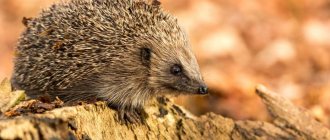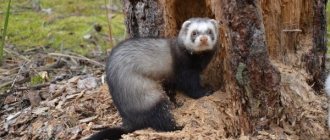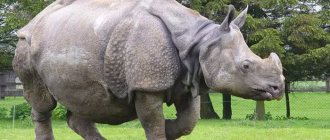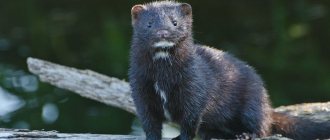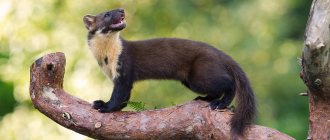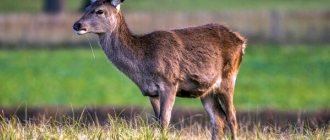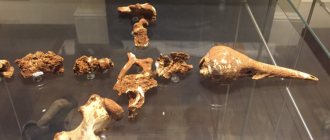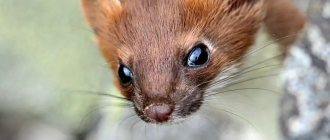The typical representative of the mustelid family is the ferret. They perfectly complement the fauna of the European part of our Motherland, living on forest edges, in the steppes and near large bodies of water. Recently, they are often introduced into homes, because a domestic ferret is a playful and active companion for any family member. However, of no less interest are the wild individuals of the ferret family - predators, aggressive and courageous, who will definitely not allow themselves to be offended.
Appearance
The wild ferret is primarily brown and black in color, with darker tails, paws and muzzle. White fur goes on the forehead, chin and ears. Lighter fur also appears on the sides and belly of the animal. Sometimes you can find other variations of what a ferret looks like - with completely red fur or albino ferrets - these are called furo.
The shiny fur is not thick, but long - on the back it can reach up to 5-6 cm. The fur becomes fluffier after the molting period - in late autumn, and before that it is not so easily soiled and lighter.
The shape of the head is oval, flattened on the sides. The head has a smooth transition line to the neck, flexible and long. Low ears with a wide base stick out on the head. The eyes are small but shiny; most often, brown eyes are found in trochees.
Ferrets have a very slender build. The animals grow from 30 to 50 cm in length. The legs are short (the hind legs are on average only 6-8 cm), but very strong and ideally developed for frequent digging of the ground. The limbs have five fingers with very sharp claws, so if you manage to catch a ferret, it will definitely be able to fend for itself.
Varieties
Stepnoy
The largest of all ferret species. They grow up to 56 cm, and their weight can exceed 2 kg. They are also called light because of the specific undercoat that shows through under the sparse brown hair. The color on the limbs and tail is dark, while the muzzle is painted with a mask.
It is not difficult to say how many years the steppe ferret lives - their age rarely exceeds 10-12 years.
Forest
The color of the forest ferret does not differ in the bright contrast of the color of the body and legs - the black-brown color of the body is complemented by the black color of the limbs and tail. They are inferior in size to their steppe counterparts - 38-48 cm in length, and weight from 500 g to 1.5 kg.
About 14 years is how long forest ferrets live, which is significantly longer than the life expectancy of their domesticated relatives.
Blackfoot (American)
The smallest individuals in the classification - their length rarely reaches 40 cm. Their fur is white at the base and dark at the tips. Overall this gives a picture of a beautiful yellow-brown color. There is a specific mask on the face.
The species is listed in the Red Book, and the life expectancy of black-footed ferrets does not exceed 6-9 years.
Habitats
Animal populations were distributed in the following geographical areas:
- Steppe ferrets in eastern Europe (Hungary, Romania, Czech Republic, Slovakia and Ukraine), Central Asia, Russia (from the Ural Mountains to the Far East) and in the eastern regions of China.
- The forest ferret can be found almost everywhere in Eurasia, especially west of the Ural Mountains.
- The central part of North America, namely east of the Rocky Mountains, is where black-footed ferrets live.
European mink population
The European mink population is rapidly declining. According to scientists, the number of animals in the wild has decreased by 50% over the past 3 generations, and continues to decline. The decline in mink numbers in Europe began in the 18th century, when the animals disappeared from Germany, Austria and Switzerland. At the beginning of the 20th century, the animals became extinct in the Czech Republic, Poland, Bulgaria and Hungary. In Latvia, Finland and Lithuania, minks were considered extinct, but a few individuals were spotted in the 1990s. In Estonia, Belarus, Moldova and Ukraine, as well as Spain and France, by this time only small fragmented populations remained. In the European part of Russia, mink was found everywhere at the beginning of the 20th century, but the number of animals began to decline rapidly in the 1950-1960s.
The most likely reasons for the decline in the number of European mink:
- reduction of natural habitat due to river drainage and agricultural land expansion. This happened throughout the 19th - 20th centuries throughout Europe - in Germany, Russia, Moldova, Ukraine, Poland, Hungary, the Baltic countries, and others.
- excessive hunting of animals for their valuable fur, especially in Russia. At the beginning of the 20th century, 40-60,000 skins were mined per year in Russia, and about 3,000 in Finland.
- a sharp decline in the number of broad-toed crayfish. These crayfish were almost completely destroyed in Europe due to the crayfish plague.
- stiff competition from American mink. American mink was brought to Europe in 1920-1930. The American species is 20-40% larger than the European species, reproduces a month earlier, and is also not so strongly attached to the shores of reservoirs, so it is easier to adapt to changed living conditions. The number of European minks was falling even before the arrival of American minks, but fierce competition for resources and diseases brought from America accelerated the decline in the population.
Habits and lifestyle
The wild ferret is a predatory animal, which is expressed in its distinctive features - aggressiveness and courage. They will not be intimidated by a confrontation with a larger opponent. Fearlessly taking on a fight is in the order of things for them.
In addition, ferrets are also characterized by ruthlessness towards their prey - by attacking a bird’s nest, the animal will satisfy its hunger and then kill every inhabitant. And all this is said about a ferret - an animal that from the outside can be called very cute.
Ferrets do not form packs, but maintain contact with their closest relatives. Moreover, in these relationships one alpha male dominates, which is more clearly expressed both during normal times and during mating. But each of the individuals has its own territory for living, which they mark by making regular rounds.
The activity of the animal occurs at night. During the day the animal sleeps, having previously dug a hole for itself. The burrow can be permanent - with a small hole and a chamber, or temporary - if movements at dawn find the animal far from home. In this case, these small predators do not shy away from using other people’s holes - hare or badger ones. And when the weather is bad, the ferret can spend several days in the hole without leaving.
What is needed to keep an animal
Before you get this pet animal, you need to prepare everything in the apartment for its occupancy and create comfortable conditions for its existence. It is imperative to know how to care for a ferret. It is important to ensure that there are no open cracks or holes in the room. Access to balconies and window sills is also undesirable, because the ferret is not adapted to objectively assessing height due to its poor eyesight.
Ferrets are inquisitive and active, interesting to watch, but their character deteriorates during puberty (at 6 months) and during the rut, which for males occurs from December to August. Sexual hunting of females lasts from February to July. To prevent a pungent smell from hanging in the house, and to make the ferret happy and sociable again, he is castrated.
Cell
The animal’s home must meet certain parameters so that keeping ferrets is only a joy for you. The animal loves space and is a real fan of houses and hammocks. The dimensions of the cage should be a cube measuring 80 by 80 cm. If the ferret feels free and comfortable in the cage, joyfully moving around it, then everything is in order with its dimensions.
And if you see that the ferret is crowded and cannot find a place for himself, come up with something else. Usually the cage contains a simulated hole, which closes the animal from human view and allows it to retire. You can build a hole from old rags. He also loves oblong pipes and dark cardboard boxes.
In addition, the pet’s home usually contains a toilet, a bowl of food, a drinking bowl and the forest animal’s personal toys. The preferred material for the cage is construction mesh. The ferret will not be able to break his teeth on it if he suddenly decides to gnaw on the cage.
Toilet
Caring for your ferret necessarily includes taking care of its personal hygiene. In the apartment, as usual, a cat litter box is used as a toilet for pets. It can be of any shape and size, the main thing is that your pet is comfortable and uses it for its intended purpose. It is advisable to secure the toilet firmly.
Nutrition
Ferrets are exclusively nocturnal animals. Only very strong hunger can force one to interrupt daytime sleep and go hunting during daylight hours.
The following representatives of the animal world become prey, namely what ferrets eat in nature:
- what the ferret eats first of all are small rodents: rats, hamsters, mice, gophers, moles and ground squirrels, hares and rabbits;
- lizards or small amphibious reptiles;
- They easily destroy found egg clutches, and sometimes attack birds.
Animals do not eat plant foods due to their digestive characteristics. However, a ferret can get nutrients from, say, fruit by eating small herbivores. It is also worth noting that in difficult situations, if it is impossible to find anything that ferrets usually eat, they are able to eat the carcasses of already dead animals.
Behavior
A ferret does not need company to go hunting. These are solitary animals; they prefer to hunt on their own. For one adult male there are about 2.5 thousand hectares of land where he will hunt. To prevent strangers from lingering in this territory, the male periodically goes around these places and places fresh marks that scare off competitors. Because of this, the males' areas rarely overlap one another. Females are less picky. They don’t care where to hunt; their territories are smaller and sometimes have no clear boundaries at all.
Reproduction
The mating period varies depending on the type of ferret: steppe ferrets begin rutting at the end of February, and forest ones - starting in April. Moreover, the rutting period may last until the end of the calendar summer.
Ferrets become mature enough to procreate at 10-12 months of their life. It is not customary for ferrets to have mating games, and the mating itself looks quite cruel: the male suppresses the female’s resistance in every possible way, biting her scruff and withers.
Females carry their offspring for almost a month and a half, and they have 4-12 cubs in a litter. Newborn ferrets are very helpless and are born blind, but development occurs quickly - after only two months of life, the mother begins to feed them meat.
Enemies
In winter, the main dangers for ferrets are wolves and foxes. An encounter with wild cats, birds of prey (eagles, golden eagles or night owls), as well as large snakes can also become unpleasant.
Among the creatures dangerous to ferrets, humans can also be mentioned. Its impact, namely the destruction of nature reserves, the construction of roads and housing in wild areas, can cause the disruption of the ferret ecosystem and the destruction of their habitats.
What traps to use
To catch ferrets, traps of different models are used. Given the nocturnal lifestyle of the predator, the trap is set in the evening. Using traps, they ensure the safety of chickens: they place the traps in a place inaccessible to the birds.
After installation, traps must be treated with a special compound that repels the human odor that frightens predators.
They use a product sold in specialized stores, manure (the trap is coated with the substance), slaked lime (applied with a brush). If the location of the ferret's hole is known, a trap is placed nearby.
To catch a predator, they use the so-called. trap No. 1. The device's guard is made especially sensitive. The bait is a bird killed by a polecat, and the animal's blood is poured into the trap.
A rat trap that is strong enough to hold a large rodent is a suitable trap for a ferret. The device is additionally weighted by attaching it to a large board to make the trap stable.
The ferret overturns a light rat trap, vigorously escaping. The freed predator, remembering the dangerous trap, always bypasses the rat traps.
Domestication of the ferret
These animals can be domesticated - they are very playful and quickly get used to their owner (especially females). They can be trained to a litter box without any problems, but if the animal likes another place to relieve itself, then another container will need to be added there.
It is worth considering that due to natural influences they will not get along with birds, small rodents or reptiles. However, they are able not only to coexist with cats or non-hunting dogs, but also to be friends.
Curiosity is another important quality of these animals. So, you should prepare for the fact that the animal will regularly and carefully examine all possible nooks and crannies in the house, climb into trash cans (and sometimes fall asleep there), and also dig up soil in flower pots.
There is another point that you can pay attention to - their life expectancy. How long ferrets live at home mainly depends on proper care and maintenance, but on average it is 5-9 years.
How to fight?
How to protect a bird from an animal that strangles chickens? In our case, a ferret. Using a trap or trap. You can use a rat trap, or you can make your own.
For this we need:
- Aluminum bucket. Plastic is lighter, and a ferret is quite capable of chewing through it.
- Two-liter plastic bottle.
- Bait (beef, lamb or chicken meat).
We make a trap like this:
- Cut off the bottom and neck of the bottle.
- We put bait in one part of it.
- We put it on the edge of the chair.
- We put a bucket under the chair.
When the ferret reaches for the tasty treat, his weight will outweigh the bottle. And the uninvited guest will fall into the bucket. The disadvantage of this trap is that it does not close on its own. The owner of the chicken coop will have to stay in the house at night in order to have time to close the bucket with the ferret.
Someone catches the pest, armed with thick gloves and an old coat. But they throw a coat on the animal, and then grab it with gloved hands. But the ferret is a fast and agile creature. It is not always possible to catch him this way.
What to do with a caught pest? Ideally, take it out into the forest and release it into the wild. Destroying is not entirely humane.
